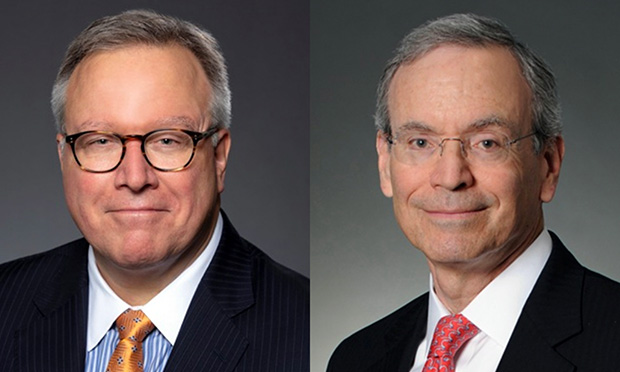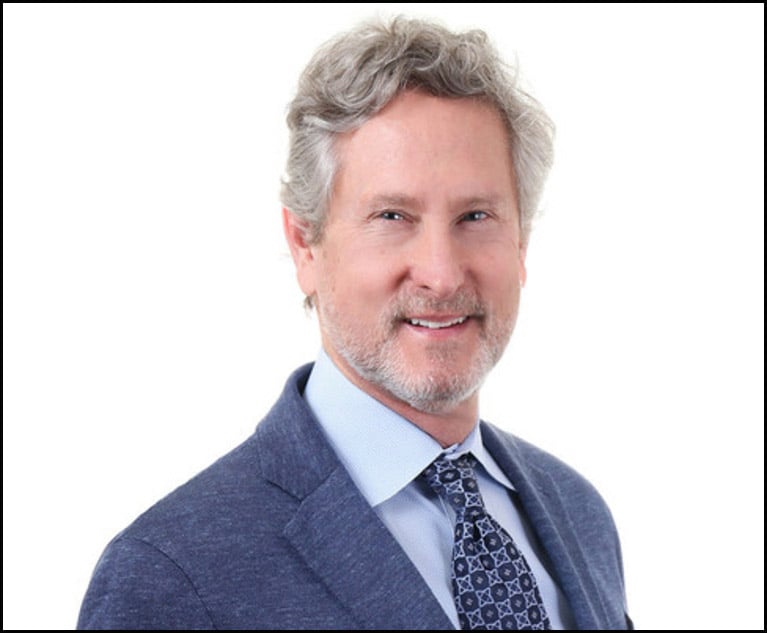Litigators of the Week: Sidley Duo’s Blockbuster Win
'Throughout the trial, whether in examining witnesses on cross or direct or in arguing to the court, we stayed true to the science. '
August 16, 2019 at 01:20 PM
9 minute read
 ( L to R) Vern Winters and David Pritikin, Sidley Austin partners (Photo: Courtesy Photo)
( L to R) Vern Winters and David Pritikin, Sidley Austin partners (Photo: Courtesy Photo)
Our Litigators of the Week are Sidley Austin’s Vernon Winters and David Pritikin, who came out on top in a patent fight worth billions to their client, Amgen and its subsidiary Immunex.
Amgen makes Enbrel, a wildly successful biologic drug which has domestic sales of nearly $5 billion per year. But three Sandoz subsidiaries of global biopharma company Novartis were poised to introduce a biosimilar version of the drug—if they could prove Enbrel’s patents were invalid.
They couldn’t.
After a two-week bench trial, a federal judge in New Jersey on August 9 sided with Winters and Pritikin in rebuffing the validity challenge—a decision that sent Amgen’s stock soaring.
Winters and Pritikin discussed the case with Lit Daily.
Lit Daily: Who is your client and what was at stake?
Pritikin: Our clients were Immunex Corporation and Amgen Manufacturing, Limited. Our opponents, three Sandoz subsidiaries of global biopharma company Novartis, were trying to invalidate patents that protect Enbrel, which is the world’s fifth-best-selling biologic, and methods to make it, so that they could import into and sell in the U.S. a biosimilar version of that product.
Tell us a little about Enbrel—what does it do and how? Why is it special?
Winters: Enbrel is a bio-engineered biologic drug that the FDA has approved to treat patients with moderate to severe rheumatoid arthritis and several other indications. It was the first so-called fusion protein—a protein made of parts of two other proteins—that the FDA approved. It is special because, as Sandoz itself told the FDA, Enbrel changed the practice of medicine. It keeps joint damage from getting worse and improves physical function in patients.
This fight has a long history—It was the first appellate challenge to the new regulatory path for creating generic versions of biologic medicines. Set the stage for what happened in 2014 before the U.S. Court of Appeals for the Federal Circuit.
Winters: Sandoz brought a declaratory relief action earlier on these same patents in the Northern District of California. Sandoz had just begun its Phase III clinical trials and had not yet sought, much less obtained, FDA approval. The district court concluded that the dispute wasn’t yet ripe under both traditional ripeness principles and also under the biosimilars statute. Sandoz appealed that decision to the Federal Circuit.
Wouldn’t it have been more efficient if the court had allowed Sandoz’s request for a declaratory judgment to proceed, to allow early resolution of patent disputes? What was your objection?
Pritikin: We thought the declaratory judgment action was premature and that the court did not have jurisdiction under traditional ripeness principles and also under the biosimilars statute. If the lawsuit had gone forward but was later vacated for lack of jurisdiction, it would have been a complete waste of time and resources because it would not have had any legal effect. The courts ruled that the lawsuit was premature.
I understand the drug’s original patents expired in 2012 and early 2014, but Amgen in 2011 licensed the rights to two new patents from Hoffmann La-Roche Inc. that will shield Enbrel from competition until 2029. Given the cost of the drug (something like $2,700 a month?), why should we root for Amgen?
Winters: You should root for Amgen because its mission is to serve patients; it is pushing the boundaries of science to transform medicine. As its CEO has said, patents are critical to create incentives for innovation and the large investments in research and development required to bring new medicines to patients and fully develop their therapeutic potential.
I should also note that, as the court found, the Roche patents were the first to describe and claim the fusion protein that is etanercept. That is why Immunex licensed the Roche patent applications in the late 1990s.
Last fall, there was a two-week bench trial before U.S. District Judge Claire Cecchi of the District of New Jersey. What was your strategy at trial?
Pritikin: Some of the science is complex, and our goal was to help the court understand through both inventor and expert testimony that the inventions were important and represented a significant contribution to the treatment of devastating autoimmune diseases.
Winters: In technology cases, the relevant facts are often highly technical—but, at the same time, are often not immediately accessible to a fact-finder. People generally don’t have first-hand, everyday experience with how to create a fusion protein, for example. So the ability to present an accessible, clear, and compelling trial narrative has particular value in technology cases.
What were some of the high (or low) points?
Pritikin: I think the court appreciated the involvement of more junior lawyers from both sides. During the trial, Judge Cecchi invited back to chambers young lawyers who for the first time had argued before the court or examined witnesses and presented each of them with a District of New Jersey mug. In cases tried today, there is often too little opportunity for young lawyers to get courtroom experience, and it was gratifying that both sides tried to do this.
Winters: In that same vein, for me the highs were watching our more junior lawyers really shine, both in the courtroom and back in the war room. A Nobel-Prize-winning expert witness I once worked with told me that he succeeded by surrounding himself with the best young people that he could, and then listening to them. Trial teams are a bit like that—a large part of why they succeed is because the young lawyers are terrific.
Who were the members of your team? What strengths did each of you bring to litigation?
Pritikin: This case required a large team—too large to list here. The in-house lawyers from Amgen were a critical part of that team, both before and at trial. We also worked with Liza Walsh, a name partner at a New Jersey firm, and her team, who are all very fine lawyers.
Our partner Jeff Kushan was another of the key Sidley lawyers on the team. Jeff successfully defeated challenges to the same patents in several IPRs and helped to develop issues across all aspects of the case. Vern and I handled most of the witnesses and divided the day-long closing argument. Aaron Maurer of Williams & Connolly, who was counsel for co-plaintiff Roche, helped.
Winters: David’s Midwestern roots prevent him from noting what a fine trial lawyer he is, so I’ll say that for him. In terms of other team members, everyone, including Amgen’s in-house team, played an important role. Amgen lawyer Drew Diamond spent months on the road with me in inventor and expert depositions all over the world in this case.
If I had to single out three Sidley lawyers, they would be: Our partner Jeff Kushan, who was instrumental in helping the team to understand and appreciate, at a deep level, the science in this case. Our young partner Steve Horowitz, who clerked for Justice Kennedy, is excellent at synthesizing morasses of facts and arguments into something that’s digestible. Our associate Sue Wang helped me enormously in preparing for cross and direct examinations of expert witnesses. But I don’t mean by singling them out to exclude anyone. Everyone contributed to this result.
Who was opposing counsel?
Pritikin: George Lombardi, the global head of Winston & Strawn’s litigation department, led Sandoz’s trial team. I have known George for many years and have tremendous respect for him.
Winters: David has worked with George before. I hadn’t. As his accolades reflect, he’s a terrific lawyer—and also a pleasant person. He and I had some nice personal interactions both during and then at the end of the trial.
I understand Sandoz conceded infringement, but argued that Roche’s patents were invalid on multiple grounds. How did you counter?
Winters: By helping the court to understand that this was an important invention. Even though he is retired, one of the named inventors flew from Switzerland to testify about this invention and its importance. We also had very well-credentialed and scientifically experienced experts, and they explained the invention and its importance in clear and compelling testimony. And throughout the trial, whether in examining witnesses on cross or direct or in arguing to the court, we stayed true to the science.
The market reaction to the win was dramatic—as my colleague Scott Graham noted, Amgen’s market cap popped $10 billion on Monday and it was the stock of the day for Investor Business Daily. What did you make of that?
Winters: I don’t hold myself out as a stock market expert, so perhaps it’s best that I leave that for others to assess. For myself, I’m just grateful that the court paid close attention to the evidence and took such care in writing up its opinion. People—and sometimes I’m guilty of this myself—don’t always remember or appreciate that trials impose enormous responsibilities and obligations on the judge.
As the biosimilar statutory regime continues to be fleshed out, what do you see as the legacy of this case?
Pritikin: That innovators are entitled to the benefits of patent protection if they have valid patents on the drugs or methods of making them. That is what encourages the research that gives us new generations of drugs.
Winters: That sums it up well: innovation deserves protection.
This content has been archived. It is available through our partners, LexisNexis® and Bloomberg Law.
To view this content, please continue to their sites.
Not a Lexis Subscriber?
Subscribe Now
Not a Bloomberg Law Subscriber?
Subscribe Now
NOT FOR REPRINT
© 2025 ALM Global, LLC, All Rights Reserved. Request academic re-use from www.copyright.com. All other uses, submit a request to [email protected]. For more information visit Asset & Logo Licensing.
You Might Like
View All
Litigators of the Week: A Trade Secret Win at the ITC for Viking Over Promising Potential Liver Drug

Litigation Leaders: Mark Jones of Nelson Mullins on Helping Clients Assemble ‘Dream Teams’

Litigators of the Week: Ingersoll Rand Enforces a Noncompete Against an Exec Who Jumped Ship to Verboten Competitor

Litigator of the Week: After Years Repping Prenatal Testing Client, First-Time First Chair Lands a $57M Patent Damages Verdict
Trending Stories
- 1ACC CLO Survey Waves Warning Flags for Boards
- 2States Accuse Trump of Thwarting Court's Funding Restoration Order
- 3Microsoft Becomes Latest Tech Company to Face Claims of Stealing Marketing Commissions From Influencers
- 4Coral Gables Attorney Busted for Stalking Lawyer
- 5Trump's DOJ Delays Releasing Jan. 6 FBI Agents List Under Consent Order
Who Got The Work
J. Brugh Lower of Gibbons has entered an appearance for industrial equipment supplier Devco Corporation in a pending trademark infringement lawsuit. The suit, accusing the defendant of selling knock-off Graco products, was filed Dec. 18 in New Jersey District Court by Rivkin Radler on behalf of Graco Inc. and Graco Minnesota. The case, assigned to U.S. District Judge Zahid N. Quraishi, is 3:24-cv-11294, Graco Inc. et al v. Devco Corporation.
Who Got The Work
Rebecca Maller-Stein and Kent A. Yalowitz of Arnold & Porter Kaye Scholer have entered their appearances for Hanaco Venture Capital and its executives, Lior Prosor and David Frankel, in a pending securities lawsuit. The action, filed on Dec. 24 in New York Southern District Court by Zell, Aron & Co. on behalf of Goldeneye Advisors, accuses the defendants of negligently and fraudulently managing the plaintiff's $1 million investment. The case, assigned to U.S. District Judge Vernon S. Broderick, is 1:24-cv-09918, Goldeneye Advisors, LLC v. Hanaco Venture Capital, Ltd. et al.
Who Got The Work
Attorneys from A&O Shearman has stepped in as defense counsel for Toronto-Dominion Bank and other defendants in a pending securities class action. The suit, filed Dec. 11 in New York Southern District Court by Bleichmar Fonti & Auld, accuses the defendants of concealing the bank's 'pervasive' deficiencies in regards to its compliance with the Bank Secrecy Act and the quality of its anti-money laundering controls. The case, assigned to U.S. District Judge Arun Subramanian, is 1:24-cv-09445, Gonzalez v. The Toronto-Dominion Bank et al.
Who Got The Work
Crown Castle International, a Pennsylvania company providing shared communications infrastructure, has turned to Luke D. Wolf of Gordon Rees Scully Mansukhani to fend off a pending breach-of-contract lawsuit. The court action, filed Nov. 25 in Michigan Eastern District Court by Hooper Hathaway PC on behalf of The Town Residences LLC, accuses Crown Castle of failing to transfer approximately $30,000 in utility payments from T-Mobile in breach of a roof-top lease and assignment agreement. The case, assigned to U.S. District Judge Susan K. Declercq, is 2:24-cv-13131, The Town Residences LLC v. T-Mobile US, Inc. et al.
Who Got The Work
Wilfred P. Coronato and Daniel M. Schwartz of McCarter & English have stepped in as defense counsel to Electrolux Home Products Inc. in a pending product liability lawsuit. The court action, filed Nov. 26 in New York Eastern District Court by Poulos Lopiccolo PC and Nagel Rice LLP on behalf of David Stern, alleges that the defendant's refrigerators’ drawers and shelving repeatedly break and fall apart within months after purchase. The case, assigned to U.S. District Judge Joan M. Azrack, is 2:24-cv-08204, Stern v. Electrolux Home Products, Inc.
Featured Firms
Law Offices of Gary Martin Hays & Associates, P.C.
(470) 294-1674
Law Offices of Mark E. Salomone
(857) 444-6468
Smith & Hassler
(713) 739-1250






